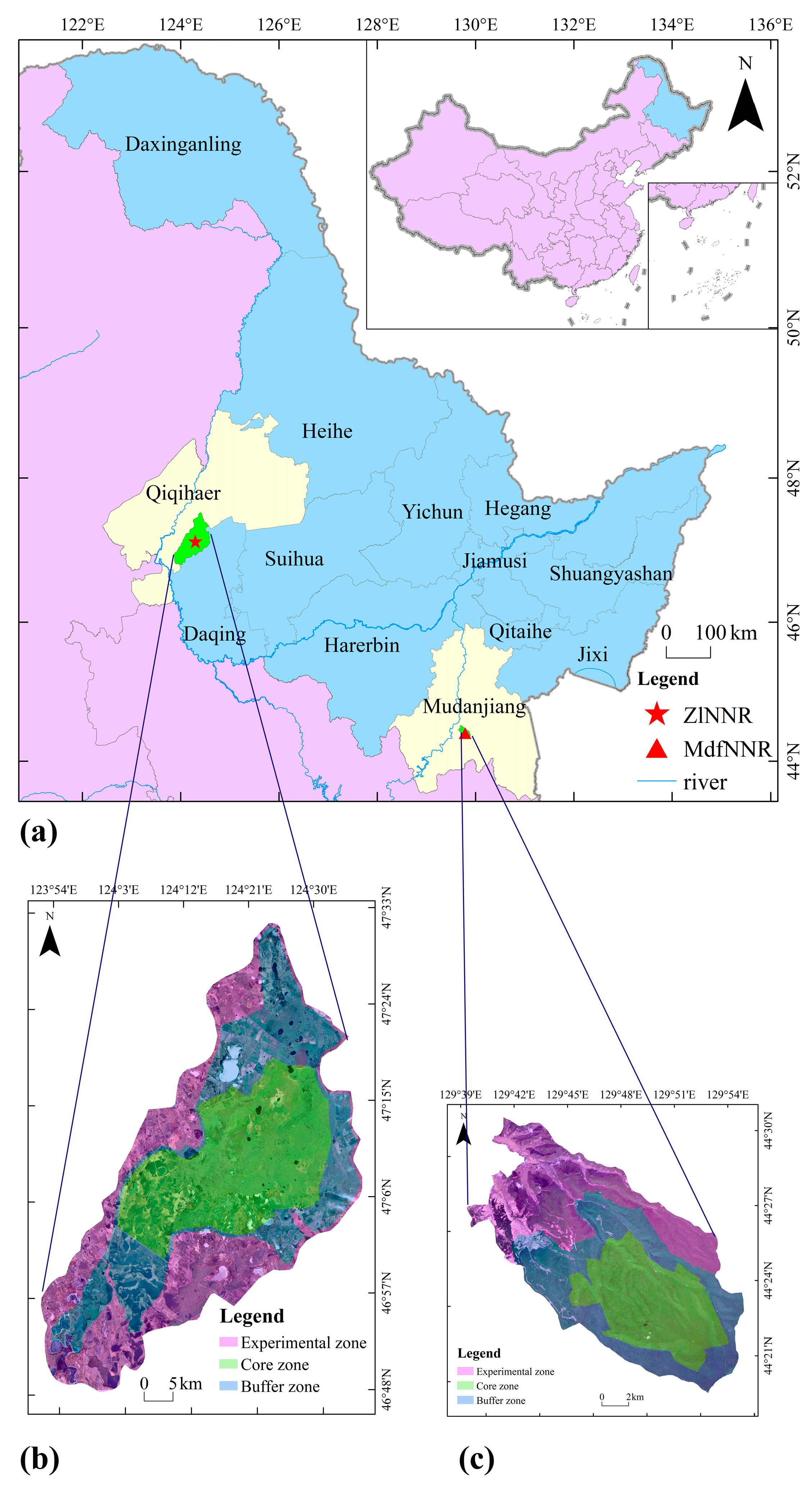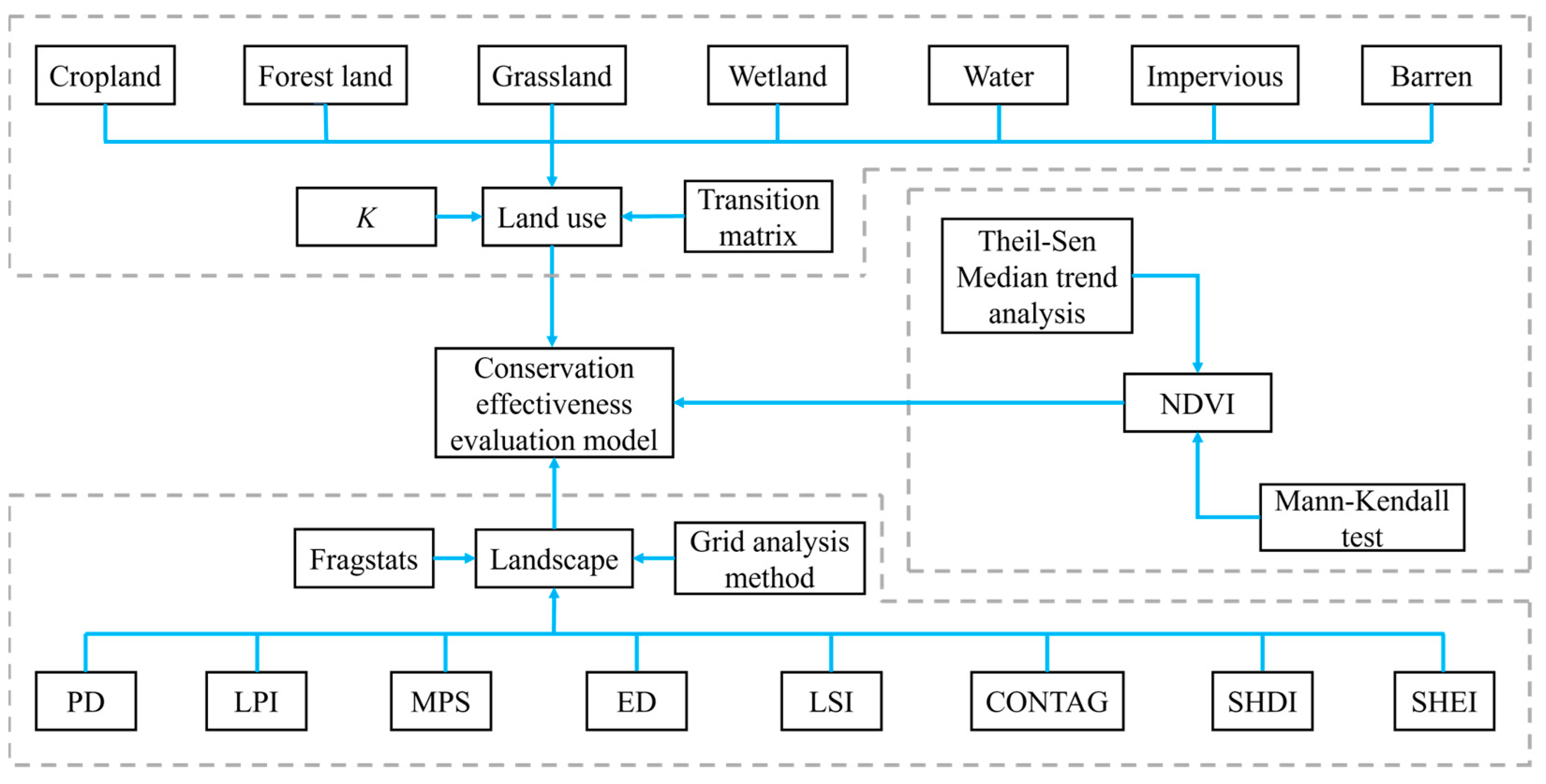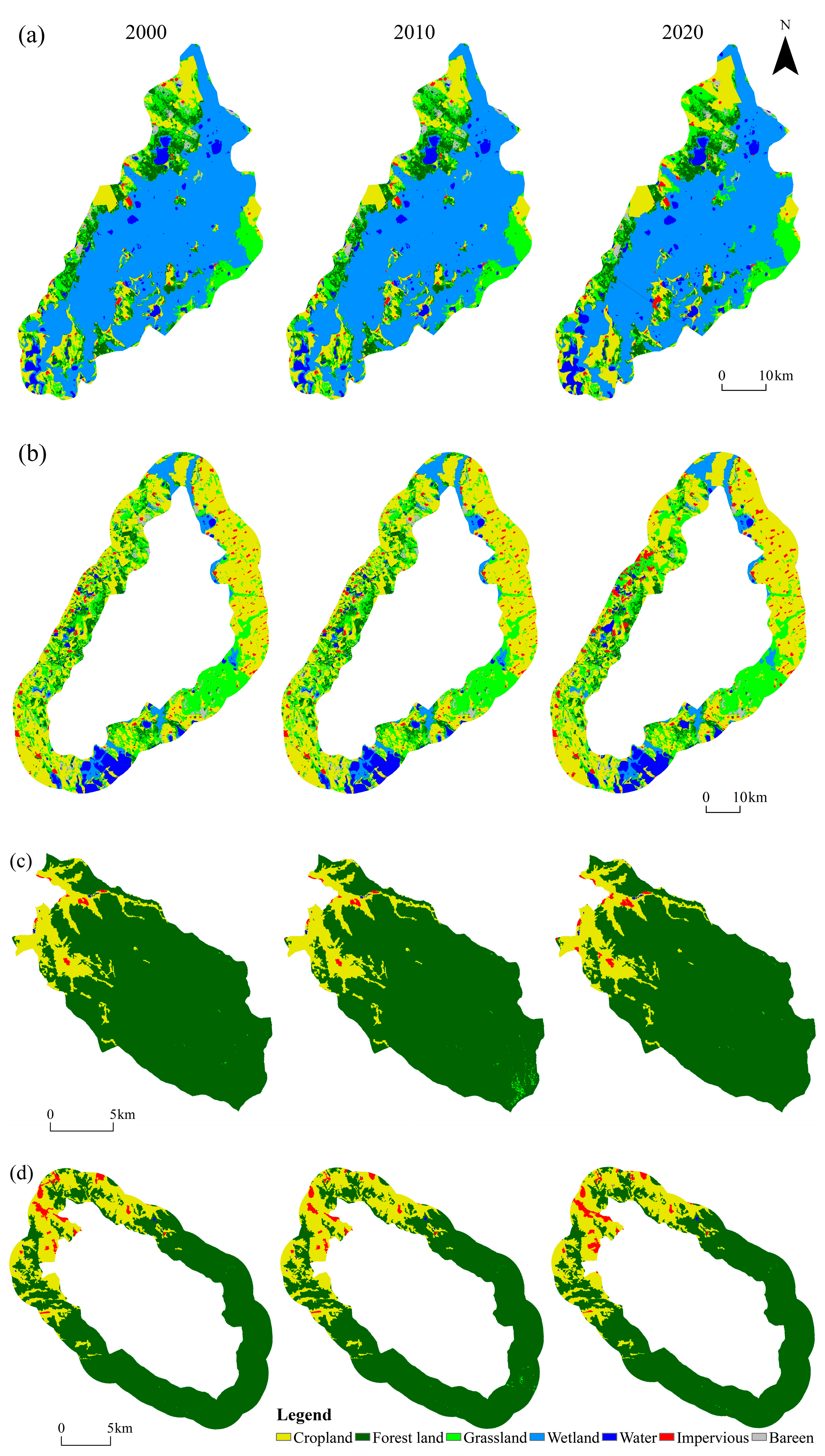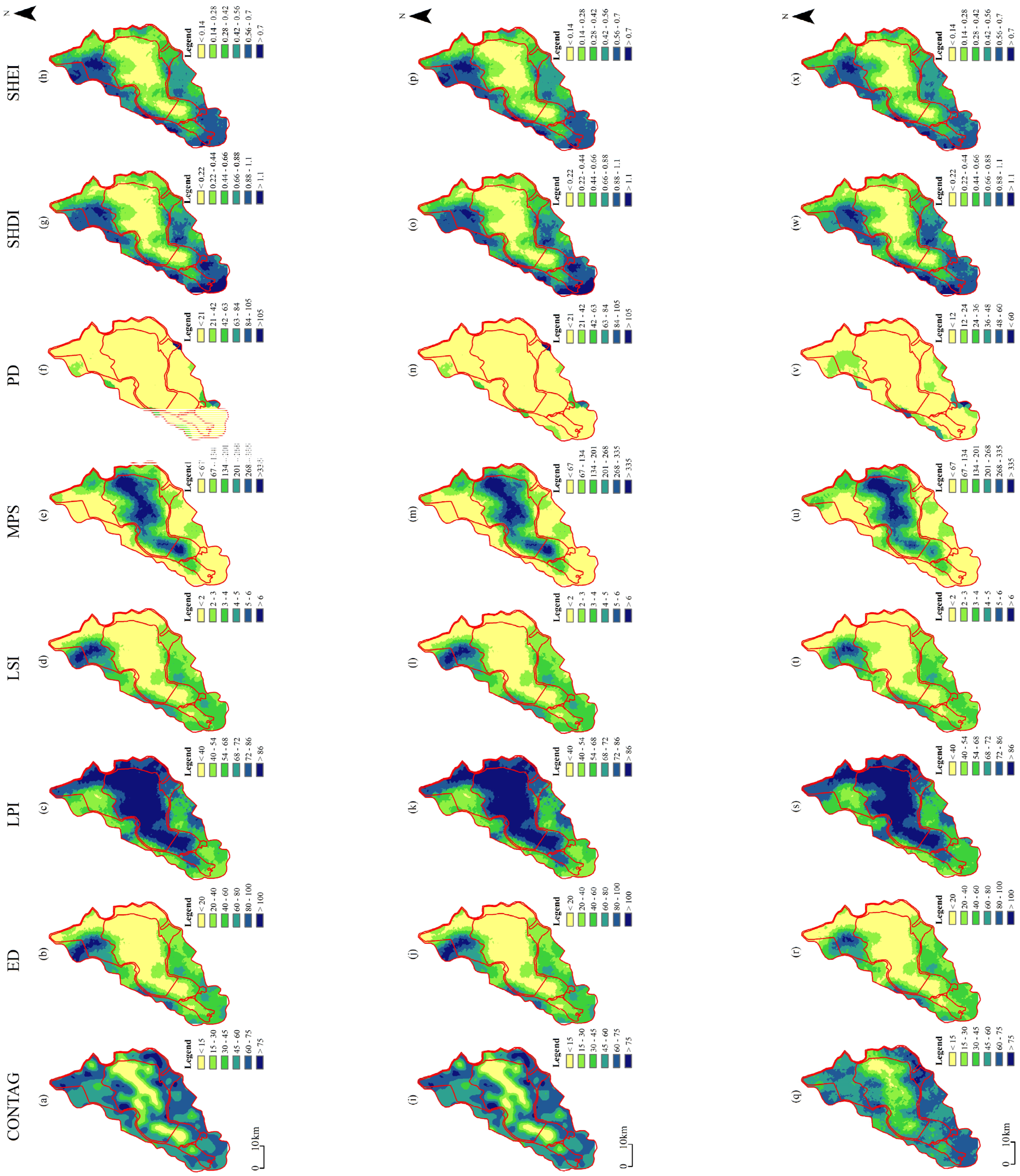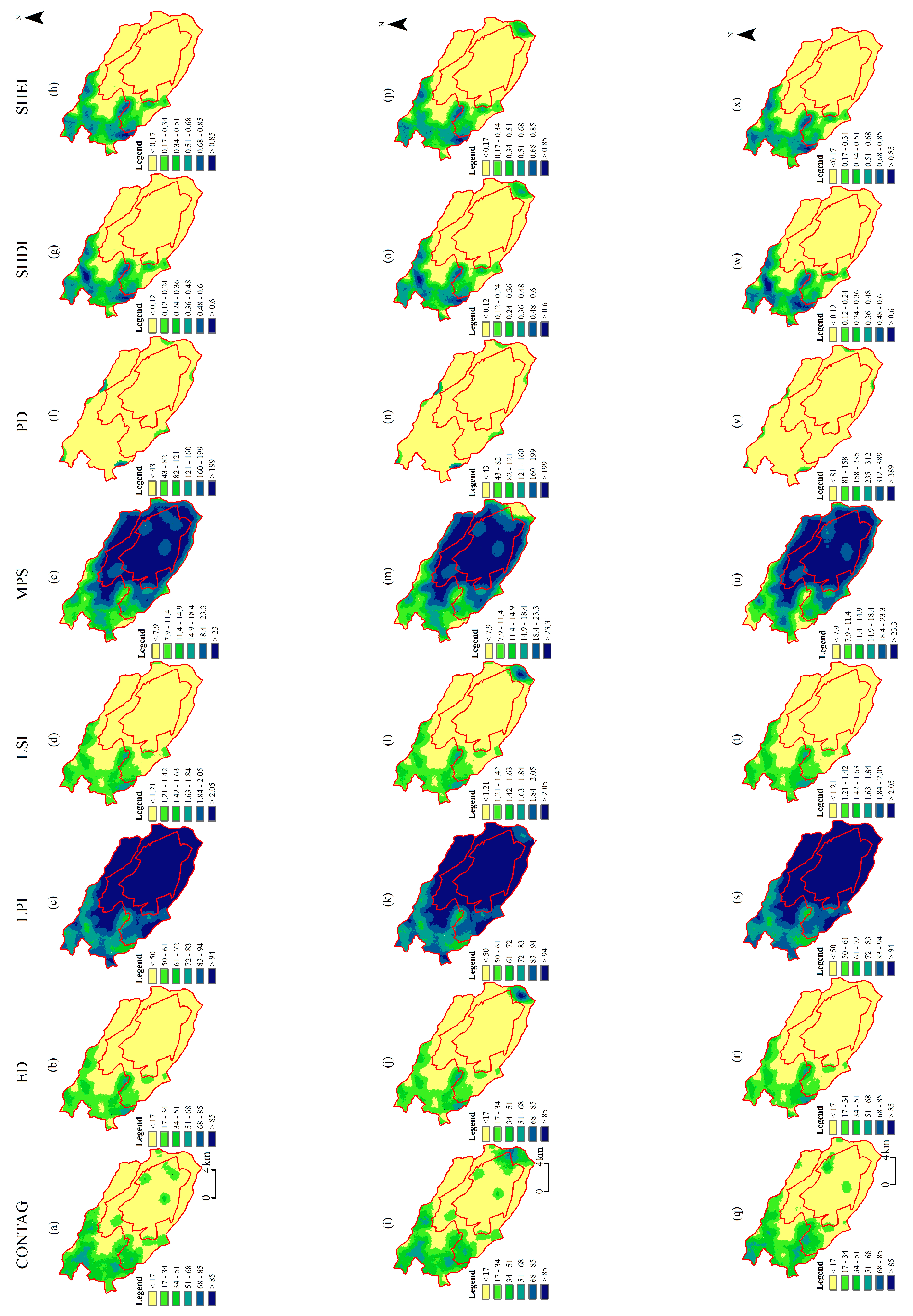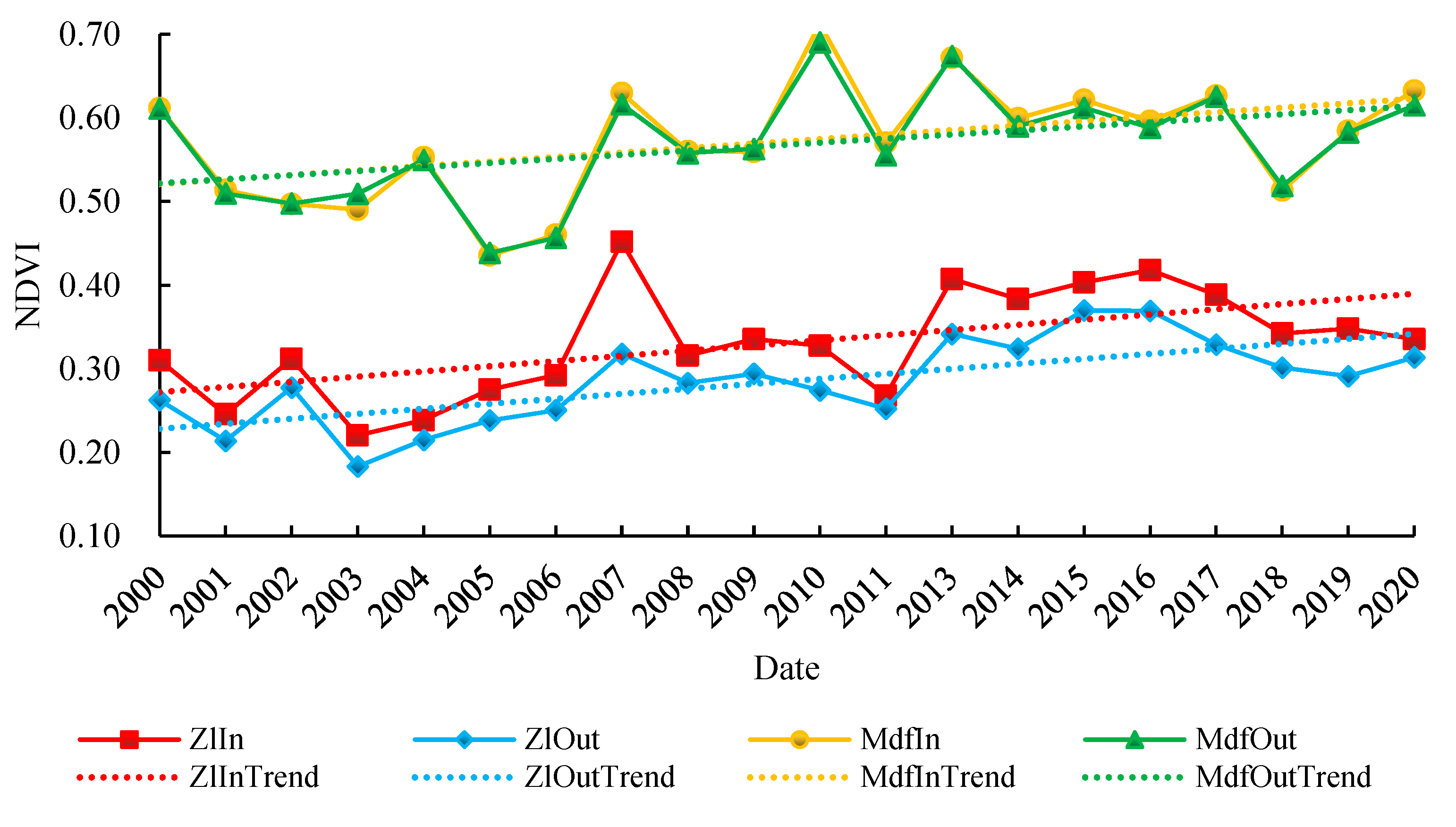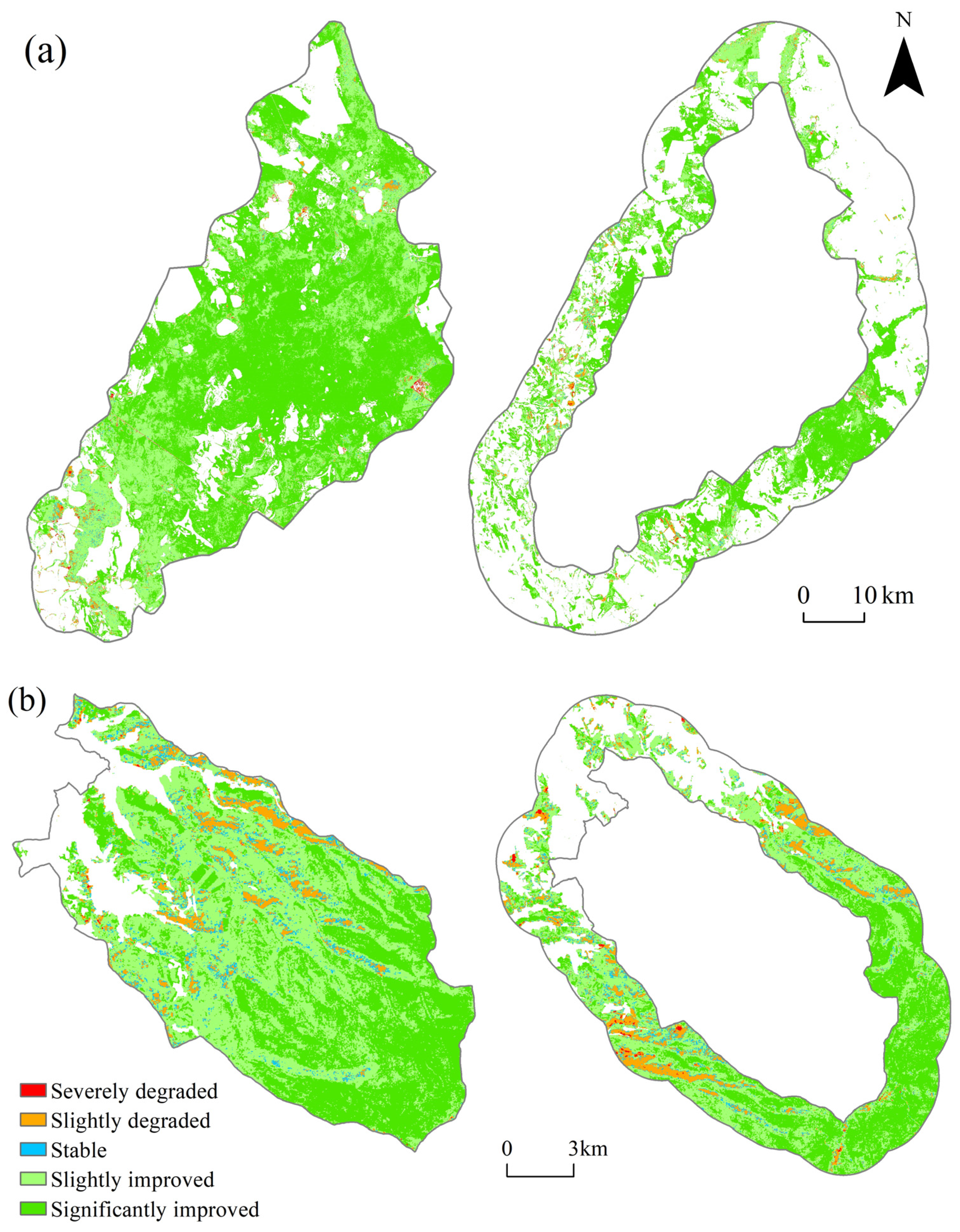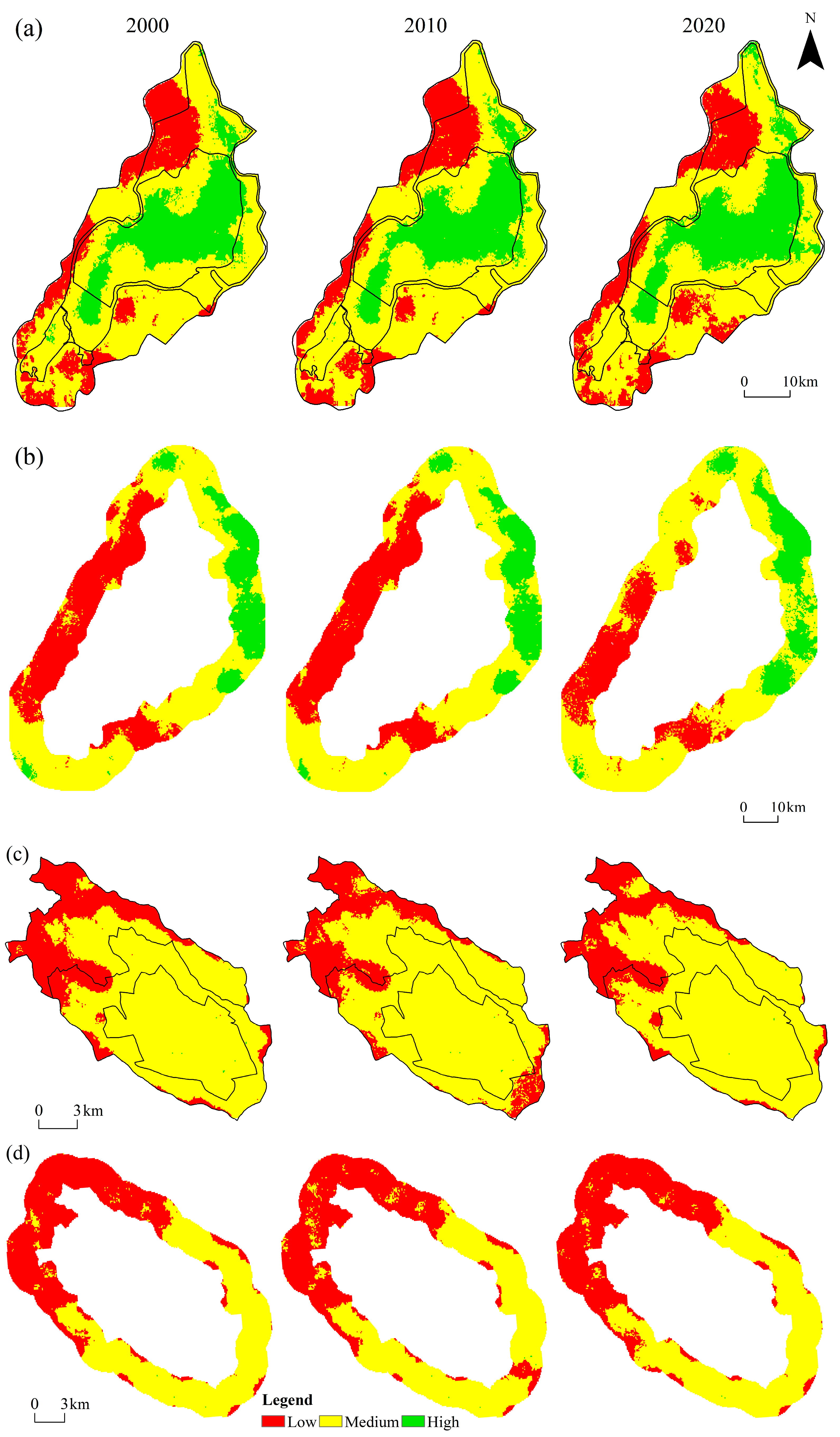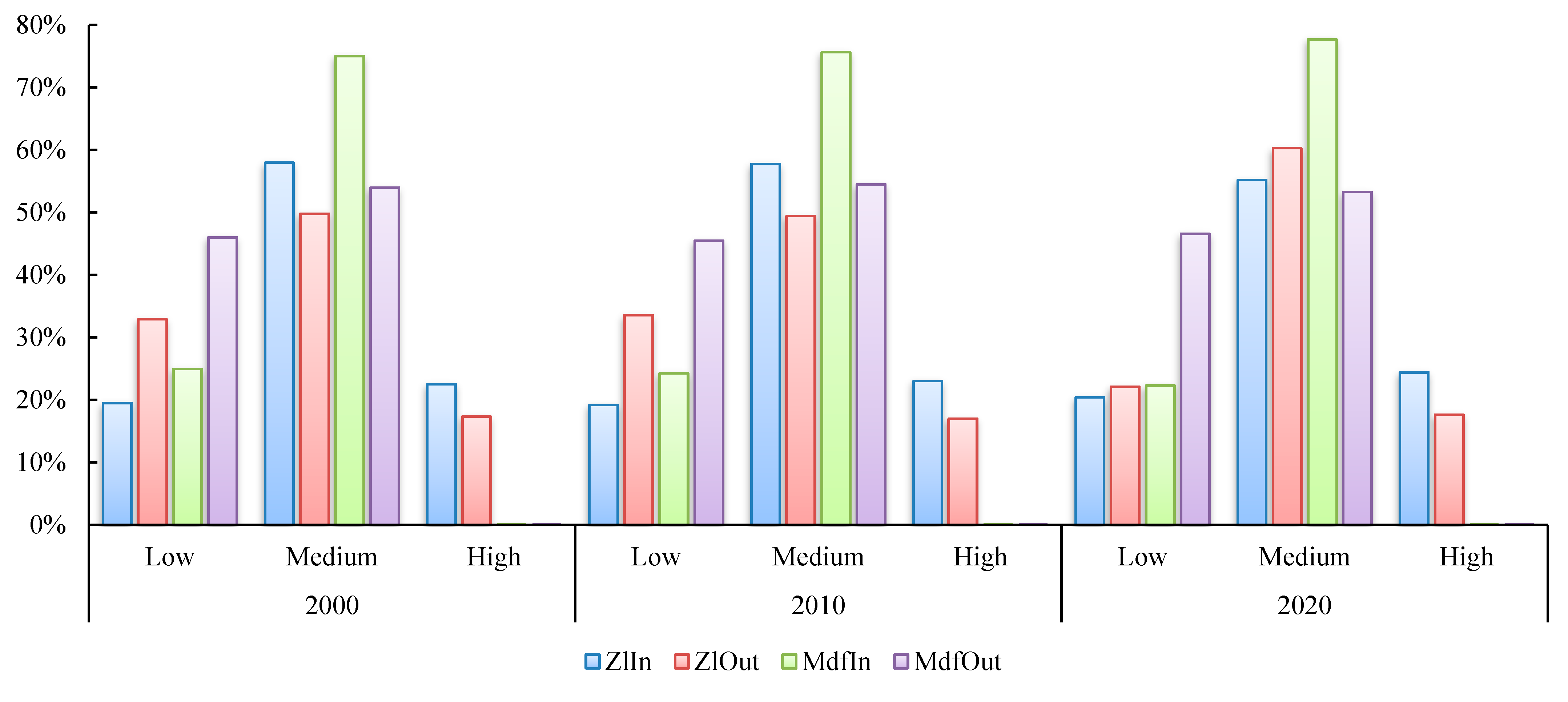1. Introduction
Protected areas (PAs), as delineated in scholarly literature, are unique geographical zones that are not only legally recognized and managed, but are also committed to the enduring preservation of nature, inclusive of the associated ecosystem services and cultural values [
1]. At present, the establishment of PAs is a pivotal global strategy for biodiversity conservation, climate change mitigation, and the reduction of human impact [
2,
3,
4,
5,
6,
7]. It also serves as a significant policy instrument for the protection of natural resources and the promotion of sustainable development [
1,
8,
9]. China, being one of the countries with the most diverse ecosystems globally, has instituted more than ten categories of PAs, which encompass 18% of its terrestrial area and 4.1% of its marine area [
10,
11,
12]. However, numerous PAs are still under considerable pressure, confronting challenges such as the exploitation of agricultural and forestry products, illegal hunting, and infrastructure development [
13]. In essence, merely augmenting the quantity and size of PAs is no longer adequate to cater to the present and future requirements of biodiversity conservation [
12,
14]. The most pressing concern at this juncture is to amplify the effectiveness of existing PAs to ensure their preservation [
15].
The effectiveness of PAs is contingent on a multitude of political, economic, and local environmental factors. There are authoritative domestic and international assessment standards for PAs, such as the Standard for Conservation Effectiveness Assessment of Ecology and Environment in Nature Reserves, promulgated by the Ministry of Ecology and Environment of China, and Evaluating Effectiveness: A Framework for Assessing Management Effectiveness of Protected Areas, published by the International Union for Conservation of Nature (IUCN), Gland, Switzerland. In practice, the assessment criteria are relatively sophisticated, necessitating specialized technical expertise, rendering implementation challenging. Furthermore, numerous studies have utilized multi-temporal historical land use data to appraise the land use/land cover changes and landscape pattern dynamics within PAs [
16,
17,
18]. Indexes such as the landscape development intensity index and landscape pressure index have been employed by academics to assess the effectiveness of safeguarding marine PAs [
19]. In addition, alterations in ecosystems, as well as the distribution and abundance of key species, also serve as indicators of conservation effectiveness [
20,
21,
22]. Nevertheless, these existing evaluation techniques are often labor-intensive and time-consuming [
23,
24], or necessitate plenty of field investigations [
21].
Remote Sensing (RS) is an advanced data acquisition technology that can swiftly, comprehensively, and accurately generate thematic data. It facilitates repeated observations of large territories and inaccessible areas, proving to be more cost-effective than field observations [
25,
26]. In recent years, research using satellite imagery to predict sustainable development outcomes has achieved rapid growth, especially studies employing machine learning methods. Satellite data with greatly improved spatial, temporal, and spectral resolutions have provided richer information on the Earth’s surface. RS meets the needs for monitoring sustainable development outcomes, with the advantages of mature technology, rapid data updates, and extensive coverage, which can satisfy the requirements of large-scale, high-precision effectiveness monitoring in PAs [
27]. The Geographic Information System (GIS), with its robust information extraction technology and spatial analysis capabilities, can accurately and efficiently address geographic issues related to resources and the environment [
28]. The significance of this technology continues to escalate, with ongoing enhancements to its role and functionality. Consequently, the integration of RS and GIS has emerged as the preferred methodology for evaluating the conservation effectiveness of PAs.
From our perspective of PAs as habitats for various species, the quality trends, whether improving or deteriorating, are an important reflection of the changing effectiveness of conservation efforts. We utilize an integrated approach of RS and GIS techniques to conduct monitoring of PA quality changes. This allows for more cost-effective and extensive spatio-temporal analyses compared to conventional methods based on localized ground surveys. Furthermore, our multi-factorial integrated assessment model employs a weighted summation method, which can effectively mitigate the limitations of single-factor evaluation lacking accuracy. This represents a methodological innovation in our research. These represent the innovations in our research ideology and analytical methodology. Thus far, many appraisals of conservation effectiveness have focused solely on either a single category of PA [
21,
29] or involved a plethora of disparate PA categories [
19,
30,
31,
32,
33,
34]. Therefore, our study aims to analyze differences in the effects of various PA types through a comparative analysis of two major types (forest and wetland PAs). By concentrating the analysis on these two predominant habitat types, we can gain deeper insights into the relative performance of PAs designated for forests versus wetlands in terms of conservation outcomes and effectiveness.
Land use change is a pivotal factor driving global environmental change [
35,
36]. It provides a direct perspective on the impact of human activities on surface ecosystems [
37], effectively mirroring the ecosystem status of PAs [
38]. Landscape pattern serves as a vital means to depict landscape structure [
39]. Landscape indexes encapsulate essential information about landscape patterns, and can serve as macro-scale surrogate indicators to perceive and comprehend changes in species and their habitats [
21]. Landscape indexes have been extensively employed to assess the effectiveness of PAs [
40,
41,
42]. The spatial and temporal variation of the Normalized Difference Vegetation Index (NDVI) is one of the most cost-effective methods for assessing ecological effectiveness [
34,
43,
44,
45]. The Google Earth Engine (GEE) Cloud Platform can swiftly and accurately process remote sensing images using its robust data calculation function. It can also obtain the best-quality images through minimum cloud amount screening for research [
46,
47,
48], thereby yielding the results of time series changes of NDVI. Consequently, employing the aforementioned factors to evaluate the effectiveness of PAs in a more systematic manner holds significant guiding implications.
Frequently, forests are often referred to as the “lungs of the earth”, playing a pivotal role in the global carbon cycle, regulating the climate system, and protecting biodiversity [
49,
50,
51,
52]. Wetlands, on the other hand, are commonly referred to as the “kidney of the earth”, providing a habitat for a vast array of species [
53], maintaining the ecological balance [
54,
55,
56], and mitigating the impact of extreme weather and other outside destructive forces on surrounding areas [
57]. Both ecosystems are critically important, yet are under severe threat [
51,
53]. The establishment of forest ecosystem PAs and wetland ecosystem PAs is a key approach to protecting forests and wetlands, and a universally powerful tool to reverse the rapid imbalance and degradation of these two ecosystems [
58]. Given disparities in the developmental status and geographic contexts of these two PA types, they may encounter differing degrees of threat and exhibit variations in biodiversity composition and structure [
30]. Consequently, their responses and outcomes regarding conservation management could diverge as well. Therefore, to what extent do differences exist in the conservation effectiveness between these two types of PAs? What are the driving factors contributing to these differences? Through comparison, we can ascertain relative superiority in habitat quality conservation outcomes, elucidate the adaptive propriety of conservation management across contrasting ecosystems, and evaluate the necessity of establishing specialized PAs grounded in particular ecological systems.
In light of the above, the objectives of this study are delineated into the following components: (1) the development of a conservation effectiveness evaluation model that incorporates parameters such as land use, landscape pattern, and NDVI; (2) the exploration of the differences in conservation effectiveness between Zhalong National Nature Reserve (ZlNNR), Qiqihaer, China and Mudanfeng National Nature Reserve (MdfNNR), Mudanjiang, China from the period of 2000 to 2020; (3) the identification of the primary driving factors influencing the conservation effectiveness of each PA, and the provision of scientifically sound and reasonable suggestions for the effective management of PAs.
3. Results
3.1. Land Use
Wetland constitutes the primary land use type in ZlNNR, accounting for approximately 50% of the total area (
Figure 3a and
Table 3). Over the span of twenty-one years, the wetlands experienced a reduction of 5115 ha (
K = −0.3998%). However, the areas of croplands and water bodies significantly increased, by 4069.4 ha (
K = 1.5820%) and 2541.58 ha (
K = 3.2692%), respectively. The change in grasslands was the least significant (
K = 0.2296%). Outside the NNR (
Figure 3b), impervious lands (
K = 5.6867%) underwent the largest change, whereas the croplands, being the primary land use type outside of ZlNNR, exhibited the smallest change range (
K = 0.0036%).
A total of 25,481.16 ha and 43,366.68 ha of land underwent transformation inside and outside ZlNNR, accounting for approximately 11.94% and 17.01% of their respective total areas (
Figure 4a,b). Among these, inside the ZlNNR, the area of grasslands experienced the largest transformation, with 8115.78 ha transferred out, accounting for 30.60% of the total area of grasslands, primarily converted into forest lands (3410.08 ha) and croplands (2894.82 ha). The area transferred from impervious lands was the smallest, with 285.76 ha transferred out, accounting for 16.51% of the total area of impervious lands, mainly converted into croplands (177.65 ha). Outside the ZlNNR, the area of grasslands transferred out was the largest (14,932.17 ha), accounting for 24.23% of the total grasslands area, and primarily converted into croplands (6615.25 ha). The area transferred from impervious lands was the smallest (877.59 ha), accounting for 12.98% of the total area of impervious lands, and mainly converted to croplands (577.69 ha). The area of wetlands both inside and outside of ZlNNR has declined.
Forest lands constitute the primary land use type both inside and outside of MdfNNR, covering 86.98% of the total area inside the reserve (
Figure 3c,d and
Table 4). Inside the MdfNNR, the area of impervious lands exhibited the largest increase of 65.35 ha (
K = 7.4021%). Conversely, the area of grasslands showed the smallest increase, expanding by a mere 1.4 ha (
K = 2.0871%). However, forest lands were the only land type that decreased in size, with a total reduction of 125 ha (
K = −0.067%). Outside the MdfNNR, only forest lands decreased in area, with a total reduction of 232.1 ha (
K = −0.1351%). The area of croplands underwent the most significant change, 138.28 ha (
K = 0.2532%). The most substantial change was observed in grasslands (
K = 15.8699%).
In total, 761.04 ha and 1582.36 ha of land inside and outside of MdfNNR underwent changes, accounting for approximately 3.58% and 6.85% of the total area inside and outside of the NNR, respectively (
Figure 4c,d). Among these, the largest transfer inside the MdfNNR was observed in forest lands, with an area of 392.26 ha and a ratio of 2.11% of the total forest lands area, primarily converted into croplands (382.24 ha). The area of grasslands transferred was the least (5.96 ha), with a ratio of 88.54% of the total grasslands area, all of which were converted into forest lands. Outside the MdfNNR, the area of forest lands transfer was the largest (740.58 ha), with a ratio of 4.33%, which was mainly converted into croplands (690.47 ha). The grasslands contributed the smallest area change of 9.25 ha, but the largest conversion ratio of 91.03% of its total area, mainly transformed into forest lands (8.13 ha).
3.2. Landscape Pattern
The patch level of the landscape pattern indexes of both NNRs are presented in
Table 5 and
Table 6. There was a negligible difference in the average values of PD
P inside and outside ZlNNR. Notably, the LPI
P and MPS
P of inside wetland patches were much larger than those of outside wetland patches. Over the past 21 years, the change extents of the three indexes were larger outside wetland patches than those of the inside wetland. Conversely, the average values of LPI
P and MPS
P outside were generally more dwarf than those inside, especially for forest land types, and the average value of PD
P outside MdfNNR was also generally larger than that inside. The change extent of PD
P and LPI
P values was generally greater outside than inside in MdfNNR, whereas the change extent of MPS
P value shows the opposite trend, with the extent of change in outside indexes being smaller than that of the inside. Whether in ZlNNR or MdfNNR, in terms of patch shape, the average values of ED
P and LSI
P are generally higher outside than inside, and the variation ranges of the two indexes were the same.
The landscape level of the landscape pattern indexes for each study area are presented in
Table 7 and
Table 8. Regarding the landscape characteristics, the change extent of the PD
L and MPS
L values was larger outside ZlNNR than inside, with the LPI
L value being greater inside ZlNNR than outside. The change extent of the PD
L and LPI
L values outside MdfNNR was larger than inside, whereas the three-year mean of LPI
L and MPS
L values was smaller outside compared to inside, with PD
L showing the opposite trend. As for changes in landscape shape, the four indexes demonstrate greater fluctuation outside the ZlNNR than inside, whereas the three-year mean of ED
L and LSI
L values was higher outside than inside, and CONTAG
L was similar between inside and outside. Additionally, the change extent of the ED
L and LSI
L values was smaller inside MdfNNR than outside, and the three-year mean of ED
L and LSI
L values was higher outside than inside. Regarding landscape diversity, the change extent of the SHDI
L and SHEI
L values was smaller inside ZlNNR than outside, and the average values of both indexes were larger inside ZlNNR than outside, but vice versa for MdfNNR.
Comparing the patch indexes between the two PAs, we found that from 2000–2020, the PDP, LPIP, and EDP values increased in MdfNNR, with water bodies increasing the most (65.74%, 53.09%, and 53.34%, respectively). The MPSP value only increased for cropland, but the increase was small, at just 1.74%, whereas other patch types decreased. Water bodies decreased the most (56.20%). The LSIP value change was negligible. In ZlNNR, both LPIP and EDP value increased, with the LPIP value of cropland increasing the most (54.95%) and the EDP value of barren land increasing the most (62.52%). The PDP value of wetlands decreased the most (63.33%), whereas MPSP increased the most for wetlands (72.32%). The LSIP value change was also negligible. Overall, wetland and impervious surface patches became more regular in shape in ZlNNR, whereas patch types became increasingly fragmented. In MdfNNR, all patch types became increasingly fragmented, especially forest, grassland, and water body patches. For landscape index, the MPSL, CONTAGL, and SHDIL values of ZlNNR increased by 134.91%, 6.93%, and 2.76% respectively, whereas the rest of the index values decreased. Notably, the PDL value decreased by 57.43%. For MdfNNR, the MPSL, SHDIL, and SHEIL values decreased by 110.7%, 124.43%, and 101.61%, respectively, whereas the other index values increased. Notably, the PDL value increased by 52.55%. This indicates that the MdfNNR landscape became increasingly fragmented with weaker connectivity, reduced diversity, and irregularity. In contrast, the ZlNNR landscape showed smaller distribution evenness changes, enhanced connectivity, increased aggregation, and more regular shapes.
The landscape-level landscape pattern indexes for both NNRs are visualized in
Figure 5 and
Figure 6.
Figure 5 reveals that the CONTAG and MPS indexes in ZlNNR exhibit a noticeable increasing trend, whereas the other indexes show no significant changes. The gap between the experimental zone and the core zone is prominent, with the extreme values of each landscape index observed in these areas. For instance, the ED and LSI of the core zone are lower, whereas the LPI is larger. Additionally, the PDs of the core zone and experimental zone are both lower, suggesting that the closer to the edge of ZlNNR, the higher the fragmentation of the landscape. However, SHDI and SHEI follow the pattern of experimental zone > buffer zone > core zone, indicating greater landscape diversity in the experimental zone.
Figure 6 shows that the indexes inside MdfNNR have changed significantly in the southeast, displaying an increasing trend from 2000 to 2010 and a decreasing trend from 2010 to 2020. Among them, CONTAG, ED, LSI, SHDI, and SHEI all exhibit a pattern of experimental zone > buffer zone > core zone, whereas LPI and MPS follow the pattern of core zone > buffer zone > experimental zone. This suggests greater landscape diversity in the experimental zone and a less fragmented and more regular landscape in the core zone. Comparing the landscape indexes of the two NNRs reveals that MdfNNR experiences greater landscape fragmentation, whereas ZlNNR exhibits a more regular landscape shape.
3.3. NDVI
3.3.1. The Temporal Variation Characteristics
The interannual variation of the NDVI, as depicted in
Figure 7, demonstrates that the annual average NDVI for each study area oscillated within a specific range and exhibited consistent temporal trends. The average annual NDVI inside and outside MdfNNR and ZlNNR ranged from 0.436–0.712, 0.439–0.690, 0.221–0.452, and 0.183–0.370, respectively. The annual average NDVI has been higher inside ZlNNR than outside over a period of nineteen years. The difference in NDVI between the inside and outside of MdfNNR is relatively small, but, overall, the inside has slightly higher NDVI values. The annual average NDVI of the MdfNNR was higher than that of the ZlNNR, primarily due to the predominance of forest land inside the MdfNNR. More specifically, the annual average NDVI of the MdfNNR experienced a steady decline from 2000 to 2003, although the rate of decline diminished each year. In 2010, the MdfNNR’s annual average NDVI peaked. From 2018 to 2020, the annual average NDVI of the MdfNNR consistently increased, with a more rapid increase observed inside than outside MdfNNR. The annual average NDVI of the ZlNNR consistently increased from 2003 to 2007, with a more rapid increase observed inside than outside ZlNNR. In 2007, the ZlNNR’s annual average NDVI reached its peak. Overall, both NNRs exhibited an upward trend in their annual average NDVI.
3.3.2. The Spatial Variation Characteristics
The distribution of improved, stable, and degraded vegetation inside ZlNNR accounted for 96.93%, 1.11%, and 1.96%, respectively (
Table 9). In contrast, outside ZlNNR, they are 93.31%, 2.10%, and 4.59%. The vegetation improvement area was 3.62% greater inside than outside, and the vegetation degradation area was 2.63% less inside than outside. As shown in
Figure 8a, the area of vegetation improvement in the ZlNNR was far greater than the area of vegetation degradation inside and outside. The areas with improved vegetation were predominantly located in the central region of the NNR and the southeast outside the NNR. Areas with slight vegetation improvement were predominantly distributed in the northeast and southwest regions of the NNR and various regions outside the NNR. Areas with stable vegetation were mainly found in the southwest region. In contrast, areas with slight and significant vegetation degradation were primarily located near water bodies and impervious lands.
The areas with improved vegetation, stable vegetation, and degraded vegetation in MdfNNR account for 88.35%, 4.84%, and 6.82%, respectively (
Table 9). Conversely, outside MdfNNR, they are 82.96%, 5.55%, and 11.49%. The improved vegetation area was 5.39% greater inside than outside, and the degraded vegetation area was 4.68% less inside than outside. As shown in
Figure 8b, the area of vegetation improvement was far greater than the area of vegetation degradation, whether inside MdfNNR or outside. Areas of notable vegetation improvement were predominantly situated in the southwest, whereas areas of slight improvement and stable vegetation were more dispersed. Regions with minor vegetation degradation were primarily found near roads, and areas with severe vegetation degradation were chiefly located near impervious land.
The time series analysis comparing the two PAs shows that ZlNNR has a higher percentage of areas with improving NDVI trends than MdfNNR. Specifically, the percentage is 8.59% higher in ZlNNR. For significantly improving trends, ZlNNR has 24.46% more area than MdfNNR. For slightly improving trends, ZlNNR has 15.88% less area than MdfNNR. On the other hand, the percentage of areas with degrading NDVI trends is 4.86% lower in ZlNNR than in MdfNNR. For severely degrading trends, ZlNNR has 0.06% more area than MdfNNR. For slightly degrading trends, ZlNNR has 6.96% less area than MdfNNR. However, the percentage of areas with stable NDVI is 3.45% lower in ZlNNR than in MdfNNR, indicating relatively stable NDVI in MdfNNR. In summary, the overall NDVI condition is better in ZlNNR compared to MdfNNR.
3.4. Comprehensive Analysis of Conservation Effectiveness
The weights assigned to each indicator in the study area were determined using the coefficient of variation method, as detailed in
Table 10.
Figure 9 presents the calculated results of conservation effectiveness for each study area. The proportions of the area corresponding to the three levels of conservation effectiveness in each study area were also computed, as depicted in
Figure 10.
For inside ZlNNR, the area characterized by HE gradually increased, whereas the area of ME progressively decreased. The area of LE initially shrank and then increased. The relative proportions of the three conservation effectiveness levels in each period followed the pattern ME > HE > LE. Conversely, outside ZlNNR, the area of LE initially increased and then decreased, whereas the areas of both ME and HE first decreased and then increased. The relative proportions of the three conservation effectiveness levels in each period followed the pattern ME > LE > HE. Moreover, the inside had a higher area proportion of HE and ME than the outside each period, whereas LE was the opposite.
For inside MdfNNR, the area of LE continues to decrease, whereas the area of ME continues to increase, and the area of HE initially increased and then decreased. The relationship between the areas occupied by the three conservation effectiveness levels in each period was ME > LE > HE. Conversely, for outside MdfNNR, the area occupied by LE initially decreased and then increased, whereas the areas occupied by both ME and HE increased and then decreased. The relationship between the areas occupied by the three conservation effectiveness levels in each period was ME > HE > LE. LE areas inside MdfNNR were less than those outside each period, and the ME areas were higher than those outside each period. For HE areas, the difference between the inside and outside of the PAs was minimal.
Both ZlNNR and MdfNNR have served their purpose of protecting vegetation and landscape to a certain extent. As expected, the core zones offer the highest conservation effectiveness, followed by buffer and experimental zones. The areas of HE in ZlNNR were more significant than those in MdfNNR in each period, and the areas of ME and LE in ZlNNR were smaller than those in MdfNNR in each period. Therefore, the conservation effectiveness of ZlNNR was superior to that of MdfNNR.
